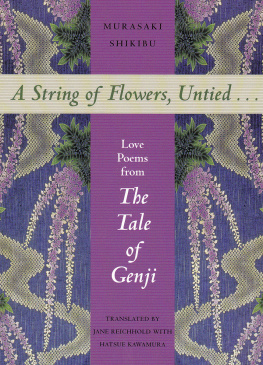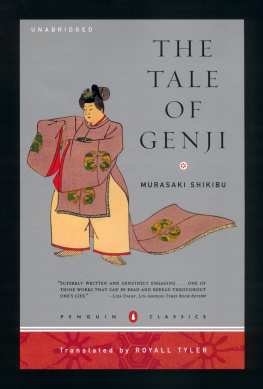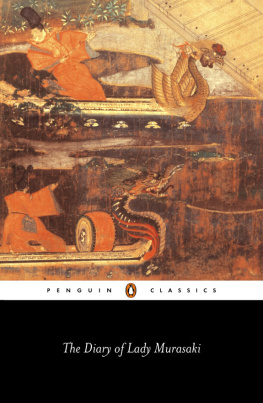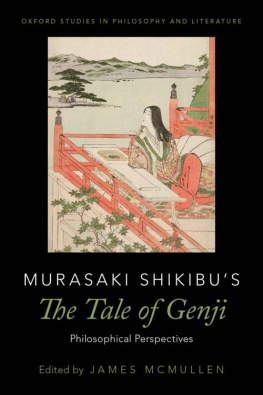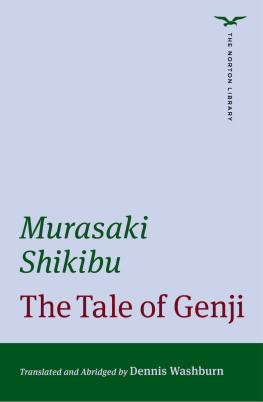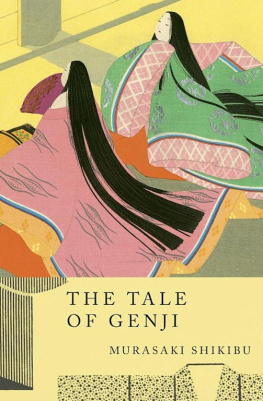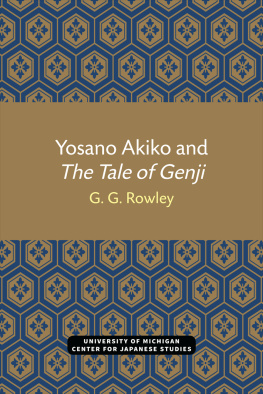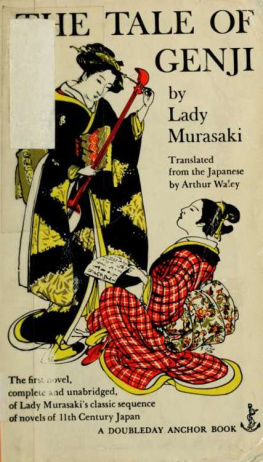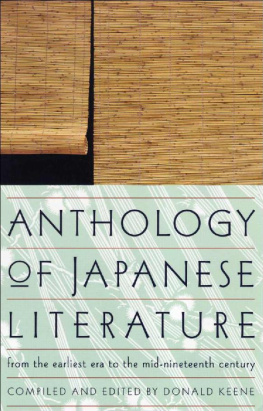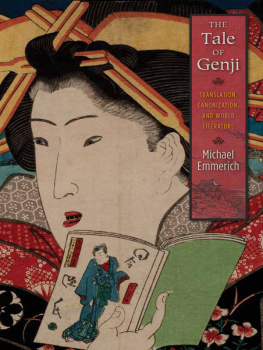Murasaki Shikibu - A String of Flowers, Untied... - Love poems from the Tale of Genji
Here you can read online Murasaki Shikibu - A String of Flowers, Untied... - Love poems from the Tale of Genji full text of the book (entire story) in english for free. Download pdf and epub, get meaning, cover and reviews about this ebook. year: 2010, publisher: Stone Bridge Press, genre: Non-fiction. Description of the work, (preface) as well as reviews are available. Best literature library LitArk.com created for fans of good reading and offers a wide selection of genres:
Romance novel
Science fiction
Adventure
Detective
Science
History
Home and family
Prose
Art
Politics
Computer
Non-fiction
Religion
Business
Children
Humor
Choose a favorite category and find really read worthwhile books. Enjoy immersion in the world of imagination, feel the emotions of the characters or learn something new for yourself, make an fascinating discovery.
- Book:A String of Flowers, Untied... - Love poems from the Tale of Genji
- Author:
- Publisher:Stone Bridge Press
- Genre:
- Year:2010
- Rating:4 / 5
- Favourites:Add to favourites
- Your mark:
- 80
- 1
- 2
- 3
- 4
- 5
A String of Flowers, Untied... - Love poems from the Tale of Genji: summary, description and annotation
We offer to read an annotation, description, summary or preface (depends on what the author of the book "A String of Flowers, Untied... - Love poems from the Tale of Genji" wrote himself). If you haven't found the necessary information about the book — write in the comments, we will try to find it.
The love poetry of the Tale of Genji by Lady Murasaki comes alive in an all-new translation.
A String of Flowers, Untied... - Love poems from the Tale of Genji — read online for free the complete book (whole text) full work
Below is the text of the book, divided by pages. System saving the place of the last page read, allows you to conveniently read the book "A String of Flowers, Untied... - Love poems from the Tale of Genji" online for free, without having to search again every time where you left off. Put a bookmark, and you can go to the page where you finished reading at any time.
Font size:
Interval:
Bookmark:
Acknowledgements
M y first and deepest thanks go to Their Majesties, Emperor Akihito and Empress Michiko of Japan. If they had not invited my husband, Werner, and me to be honored guests at the Utakai Hijime (The New Year's Poetry Party) at the Imperial Court in January 1998, I never would have had the courage to attempt to fulfill my dream of giving Murasaki Shikibu's poetry a new life. It was through the experience of attending this famous tanka poetry event that I glimpsed the importance of tanka in Japanese life and the history of the country.
This trip was made possible through the kindnesses and donations of Mr. Hojo Nakajima, Vice Grand Master of the Ceremonies of the Imperial Household; Mr. Kazuo Ito of Star in the Forest Publishing Company (Hoshi to Mori); Professor Takashi Aoyagi, the Japanese voice of Mickey Mouse; Mr. Etsuo Yamamoto, Mr. Shinsuke Arai, Mr. Michiro Ohbayashi, and Fr. Neal Henry Lawrence, OSB, the American tanka poet at St. Anselm's Priory. Special thanks to the translators during the trip, Mr. Misao Okimoto and Michiko Kga, who not only helped us across cultural barriers of words but also gave us so much delight while at the same time educating us. A special thanks belongs to Takuro Ajiki and Sei'ichir Nakagae, who made the day in Atami so magical. The greatest burden of the work organizing the trip and our days fell to Mr. Matsuo Shukuya, member of the Society of the Reizei Family, to whom we continually give our thanks and our wonder for all he accomplished.
If this trip had not been possible, I never would have met Professor Hatsue Kawamura, editor of The Tanka Journal , and her husband, Yasuhiro, that snowy night at the Garden Palace Hotel, where we first talked about this project. It was only through her most patient and kind way of showing me how to translate the Japanese poems that our work on this book and the other two, White Letter Poems by Fumi Saito and Heavenly Maiden Tanka by Akiko Baba, has been realized. No one has been as good to work with as Hatsue is and I have only endless praise for her as a person and her abilities in both English and poetry.
My thanks to Leza Lowitz for her encouragement and for suggesting that her Japanese translator, Miyuki Aoyama, be the one more pair of eyes to go over the romaji . Miyuki Aoyama took time she did not have to willingly give so much help. My gratitude goes to Dr. Amy Vladeck Heinrich for her expertise on so many questions and her patience in reading the first thirteen chapters before her own important work called her back to Japan. Help was also given by correspondence with Aya Yuhki, Sumiko Koganei, Janine Beichman, and Sanford Goldstein. D. S. Lliteras also gave continual encouragement for the work, up to and including today, through so many long phone calls.
I gratefully acknowledge the foresight and forbearance Peter Goodman showed through the many necessary revisions of the manuscript. The staff at Stone Bridge Press has been marvelously kind and efficient through every phase of getting the poems into a book. Michael Ashby did a yeoman's job of copyediting, for which I am extremely grateful.
I am also grateful to the spirits of Murasaki Shikibu and Akiko Yosano, who I always felt were guiding the sometimes rocky course of the translations. I cannot relate how often I came to the place of not knowing how to state a line until, in a quietness of waiting, the words would form themselves with a clarity greater than my own understanding.
Last, but surely never least, my thanks to Werner, my husband, who gave me the life, peace, and companionship that nourished each day.
J.R.
The Tale Of Genji as a Book
B ecause so many of the questions about how Murasaki Shikibu came to write The Tale of Genji are impossible to answer definitively, scholars through the millennium have lent their minds to solving the many riddles the work creates. Most of what we believe is conjecture, and there is always another learned expert waiting in the wings who has a different opinion.
It is thought that Murasaki Shikibu probably began writing the story around 1002 or 1003 A.D. It was surely written after the death of her husband and before she entered the service of Empress Shshi (Akiko), consort of Emperor Ichij, in 10051006. There is a reference in The Sarashina Diary , written in about 1021, that mentions that the author (another literary woman at the same court) was given the fifty-plus scrolls of the novel, so we know that the series had been completed by then. During the time of her own service to Empress Shshi, Shikibu also kept a diary ( Murasaki Shikibu Nikki ), between autumn 1008 and 1010, in which she recorded the events of the imperial scene, but she gives very little information there about her work as a novelist. She does mention that her work The Tale of Genji was read to Emperor Ichij, who then ordered the finest papers, brushes, and inks for additional copies.
It seems that the book was written in chapters, each of which consisted of a scroll. Although at this time, the Japanese were already printing Buddhist texts with carved wooden blocks, novels and diaries continued, up until the nineteenth century, to be copied by hand in calligraphy. A reading of the complete work reveals variations in style and outlook, which have suggested to some authorities that perhaps more than one person contributed to the work.
However, it is usually agreed that the first thirty-three chapters are probably the work of one author and that chapter 33 presents a logical conclusion. It has been argued that Shikibu was male (a theory now put to rest) and that even the thirty-three chapters show a marked split in them, following first one female main character, Murasaki, and then another, Tamakazura (Lady Jeweled Garland). Although the arrangement of the chapters we now follow has been done to make the story as sequential as possible, some of the chapters do overlap, and occasionally events are mentioned or characters referred to before they make their appearance later in the story.
It has been argued that Shikibu meant to end her story with chapter 33, with the Shining Prince at the pinnacle of his success and all the love affairs and dilemmas resolved. Whether Shikibu, after some lapse of time and life, picked up the story again, which is now more subdued with sadness and regrets, to continue another eight scrolls until Genji dies at the end of chapter 41, or someone else wrote the sequel, we cannot know. It has also been proposed that Shikibus own daughter, Daini no Sammi, continued the story, if not at chapter 33, then perhaps the last thirteen chapters, which are even more disparate in the handling of the altogether different characters and philosophical outlook.
Even fifty-four as the total number of chapters is volatile, since there is reported to have been a chapter titled "Kumogakure" (disappearance in the clouds), which may have described the death and funeral of Genji. Some claim that this chapter existed only as a title, indicating that the grief of describing such sad events was too much to write down. Others claim the chapter has only been lost and not yet found or was suppressed and is thus lost.
The oldest copies of the chapters are those saved from 200 years after the tale was written down, so much of the original has been lost and is therefore open to speculation.
The one question that has occupied scholars for the longest time is how a woman could write a story that stands like a great mountain above the rolling hills of the known literature of that time. Yes, there were oral tales and romances, some that are available still today. It is possible that there was an oral version of some of The Tale of Genji , and there is certainly evidence that a person much like Genji lived about seventy years before Shikibus birth. However, Shikibus work is so much more complex, more developed, and bestowed with such a sweeping scope, that one can only admit she was surely a genius who built on the available literature to make it soar.
Next pageFont size:
Interval:
Bookmark:
Similar books «A String of Flowers, Untied... - Love poems from the Tale of Genji»
Look at similar books to A String of Flowers, Untied... - Love poems from the Tale of Genji. We have selected literature similar in name and meaning in the hope of providing readers with more options to find new, interesting, not yet read works.
Discussion, reviews of the book A String of Flowers, Untied... - Love poems from the Tale of Genji and just readers' own opinions. Leave your comments, write what you think about the work, its meaning or the main characters. Specify what exactly you liked and what you didn't like, and why you think so.

